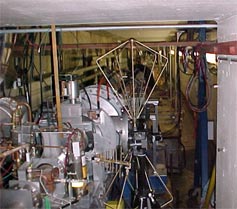
Handy Links
SLAC News Center
SLAC Today
- Subscribe
- Archives: Feb 2006-May 20, 2011
- Archives: May 23, 2011 and later
- Submit Feedback or Story Ideas
- About SLAC Today
SLAC News
Lab News
- Interactions
- Lightsources.org
- ILC NewsLine
- Int'l Science Grid This Week
- Fermilab Today
- Berkeley Lab News
- @brookhaven TODAY
- DOE Pulse
- CERN Courier
- DESY inForm
- US / LHC
SLAC Links
- Emergency
- Safety
- Policy Repository
- Site Entry Form

- Site Maps
- M & O Review
- Computing Status & Calendar
- SLAC Colloquium
- SLACspeak
- SLACspace
- SLAC Logo
- Café Menu
- Flea Market
- Web E-mail
- Marguerite Shuttle
- Discount Commuter Passes
-
Award Reporting Form
- SPIRES
- SciDoc
- Activity Groups
- Library
Stanford
Around the Bay
Protecting Against Electromagnetic Interference
 By placing electronics from the retired SLAC Large Detector (SLD) next to a test beam in End Station A, a small group of experimenters is learning how to protect the detector electronics of the proposed International Linear Collider (ILC).
By placing electronics from the retired SLAC Large Detector (SLD) next to a test beam in End Station A, a small group of experimenters is learning how to protect the detector electronics of the proposed International Linear Collider (ILC).
Electromagnetic interference is a real concern for the ILC, where very short particle bunches will emit electromagnetic radiation as they travel through beam pipes toward the center of the detector.
In the world's first linear collider—the SLC—the detector electronics close to the beam pipe failed, probably due to electromagnetic interference. Physicists worked around the problem by instructing the electronics to wait to read out until after each bunch of particles had passed by. At the ILC, however, the time between particle collisions will be vastly shorter, once every 300 nanoseconds, rather than every eight million nanoseconds. The ILC electronics must read out constantly.
Researchers Gary Bower and Nick Sinev are using the test beam to test the effectiveness of shielding, which can be as simple as aluminum foil wrapped around the beam pipe. For three weeks this month, the test beam mimics the ILC beam in bunch length and charge, allowing multiple R&D groups from around the world to develop ways to monitor, characterize, and improve the ILC beam.
The beam pipes have holes through them that contain beam position monitors and other instruments to measure beam characteristics just before a collision. Each short bunch of particles generates an electric field that can escape through these gaps in the beam pipe and generate short, intense radio waves and microwaves. The researchers have reproduced the failure of the SLD electronics, used antennas to measure the amount of electromagnetic interference, and determined that the signals propagate through the air and wash over the electronics.
If researchers can isolate which particular frequency of waves causes interference, it may help with electronics design. Even if the problem can't be isolated, results from earlier test beam runs show that shielding is a possible solution.
—Heather Rock Woods, March 20, 2007
Above image: An "eggbeater," or biconical antenna, sits next to the beamline in End Station A to measure electromagnetic interference. Researchers also use a smaller TV-style log-periodic antenna (overlapping the lower left half of the eggbeater).